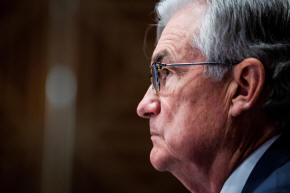Analysis-For Fed's Powell, 2019 remains the touchstone for a
post-pandemic economy
 Send a link to a friend
Send a link to a friend
 [March 21, 2022] By
Howard Schneider and Ann Saphir [March 21, 2022] By
Howard Schneider and Ann Saphir
(Reuters) - Federal Reserve Chair Jerome
Powell has often pointed to the months before the pandemic as a heyday
for the U.S. economy, and he is counting on an across-the-board return
to economic conditions circa 2019 to help win a fight against high
inflation without sparking higher unemployment.
It is a calculated gamble the world economy will emerge from the
pandemic, a war in eastern Europe, and a potential reshuffling of global
supply lines and still largely operate as it did before, without any
permanent change in price and wage dynamics.
When pressed on the seeming tension in the Fed's latest economic
projections, in which inflation gradually falls even as the unemployment
rate remains near historic lows, Powell dialed back the clock and noted
it had happened before.
"In the economy we had before the pandemic, the connection between
inflation and the level of the unemployment rate was not very tight,"
Powell said, adding the Fed's shift to higher interest rates shouldn't
raise joblessness, only curb what he said is an "unhealthy" level of
demand for workers that is causing outsized wage increases.
"Across the economy we would like to slow demand so it is better aligned
with supply," Powell said, but not so much that it raises the
unemployment rate and triggers a recession.

The Fed at its meeting last Wednesday penciled in what would be the
fastest set of interest rate increases in 20 years to address inflation
that is running at a 40-year high. It lifted the target federal funds
rate by a quarter of a percentage point from the near zero rate
established at the start of the pandemic, and policymakers projected the
equivalent of a quarter-point increase at each of their six remaining
meetings this year.
Some officials want to move faster, and some analysts have noted that
when rates move along the lines the Fed is already projecting it tends
to end in recession - not the "soft landing" Powell intends.
Fed Governor Christopher Waller, who would like to "front load" several
half-point rate hikes at coming meetings, pushed back on that as a risk.
"As far as recession I don't think that there should be a great concern
on this," he said Friday on CNBC. "We are talking about mainly getting
to neutral or slightly above it by the end of the year, and that
shouldn’t be any cause for concern for recession."
TACTICAL GUIDANCE
Yet it was clear from the Fed's post-meeting statement and Powell's
press conference following its release that much is left unresolved
about the central bank's policy shift.
Major central banks in recent decades have put a premium on transparency
and consider clear guidance about the path of policy as an important
tool. Rate hike cycles have typically been described by words like
"measured" or "gradual" that provide a clear steer on the pace of
increases.
Fed policymaker projections pointed to hikes at each meeting, a more
hawkish outlook than expected. But the projections have proved a poor
predictor of actual policy decisions. The more binding policy statement
- a consensus document voted on by the Federal Open Market Committee -
referred only to "ongoing increases," potentially leaving the door open
for the Fed to speed or slow its pace as needed.
"The Fed would rather sound hawkish and have to back off, than sound
dovish and have to play catch-up in the current environment," said
Standard Chartered economist Steve Englander.

Providing direction alone may be a tactical move by the Fed but it may
also be a product of the moment, and uncertainty about whether the
economy emerging from the health crisis will indeed snap back to
pre-pandemic form.
[to top of second column] |

U.S. Federal Reserve Chairman Jerome Powell testifies during the
Senate Banking Committee hearing titled "The Semiannual Monetary
Policy Report to the Congress", in Washington, U.S., March 3, 2022.
Tom Williams/Pool via REUTERS/File Photo

A lot will have to go right, including an improved global flow of goods,
continued progress on the pandemic, shifts in consumer spending, and a jump in
the number of people who want to work. Improved labor supply is one way the
unemployment rate can stay low and job growth continue without adding to wage or
price pressures. The war in Ukraine is perhaps the biggest risk, with the
potential to drive higher inflation through, for example, higher commodity
prices.
A PRE-PANDEMIC IDEAL
The outlook sketched by the Fed seemed "more idealistic than realistic," said
Nela Richardson, chief economist for payroll processor ADP. "This is a different
economy. Inflation is present. We have a world that has been dramatically
transformed by the pandemic and is now grappling with a humanitarian crisis."
Powell became chair in 2018 after several years as a Fed governor. The Fed was
then already steadily lifting rates in anticipation that unexpectedly strong
economic growth and government deficit spending would increase inflation.
What happened instead surprised policymakers, and created what Powell has
described as a sort of golden moment of balance in the economy.
The unemployment rate in 2019 remained below 4%, a low level that under the
Fed's baseline view of the economy should have provoked inflation. Yet inflation
remained at or below the Fed's 2% target. Wage growth, at just over 3% annually,
let workers' pay keep pace with prices and then some - but stayed roughly in
line with annual changes in employee productivity so companies were not pushed
to either raise prices or cut profits.
More people started looking for jobs, with some older people even leaving
retirement because of the higher pay.
'WE WILL DEAL WITH WHAT COMES'
The pandemic wrecked all that, and as the economy reopened that 2019 moment of
balance gave way to an unpredictable mess.

Using a statistic Powell often cites, the number of jobs for each unemployed
worker was high in 2018 and 2019 at around 1.2; it exploded during the pandemic
to 1.7 jobs per jobless individual.
The unemployment rate is now 3.8% and the Fed thinks it will fall this year to
3.5% and remain around there through 2024. Inflation by a key measure is 6%,
triple the Fed's target, outpacing wage increases for most people, and
threatening to go higher.
There is some logic to Powell's argument about the labor force, said Glassdoor
Senior Economist Daniel Zhao.
"Right now demand for workers exceeds supply by so much that you could have a
slowdown in demand that wouldn't necessarily affect jobs growth," Zhao said. "It
might put a damper on wage growth; let's say a worker has three offers - that
gives them more negotiating power than one. In both cases the worker will go to
a new job."
But Powell was careful not to over-promise.
"The reality is there are many many moving pieces and we don't know what will
actually happen," Powell said. "We will deal with what comes whether it is
better or worse."
(Reporting by Howard Schneider; Editing by Dan Burns and Andrea Ricci)
[© 2022 Thomson Reuters. All rights
reserved.]This material may not be published,
broadcast, rewritten or redistributed.
Thompson Reuters is solely responsible for this content. |